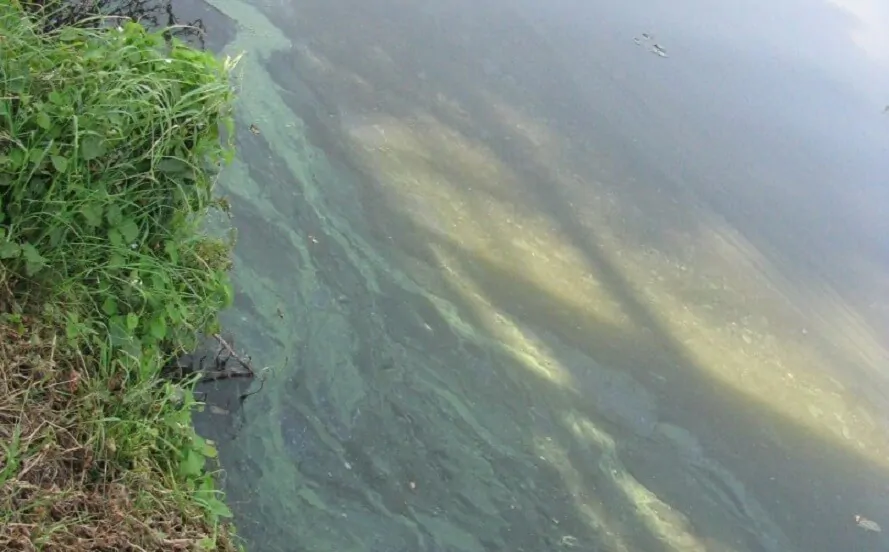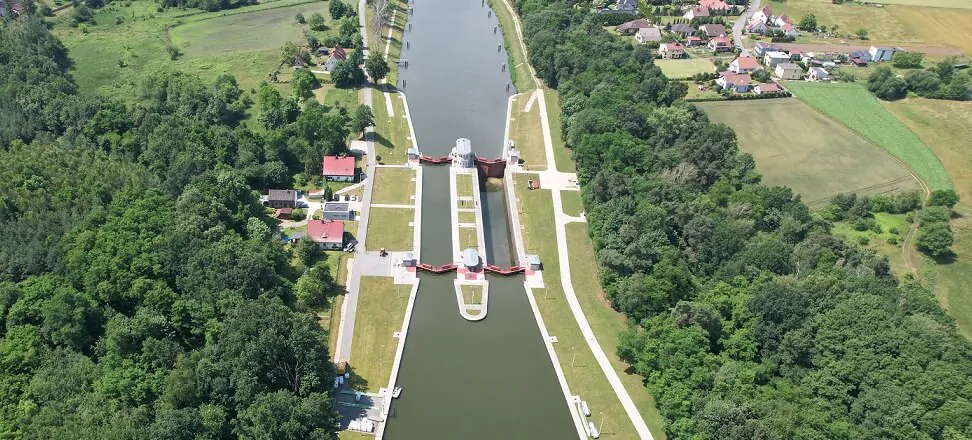Issue 14/2024, News
Fighting golden algae with SinStop
A golden algae bloom is increasingly threatening aquatic ecosystems in Poland, leading to massive fish die-offs and ecological imbalances. In response to this alarming phenomenon, a team of scientists from the Institute of Meteorology and Water Management – National Research Institute (IMGW-PIB) and the Ecco-Logic company, in cooperation with Polish Water, has developed an innovative solution. The method uses SinStop, which is designed to effectively combat harmful algae.
SinStop research methodology
Initial work with SinStop was carried out under laboratory conditions. Then, the method was tested on the Gliwice Canal, in the area of Slawecice and Rudziniec locks. The field experiment lasted two months.
The research was aimed at evaluating the effectiveness of SinStop in reducing the golden population, which is, as the manufacturer declares, a natural agent based on silicon compounds. The research process was divided into two key stages: testing of technological variants and operational research.
Stage one: technology testing
In the first stage of the experiment, 12 different technological variants were tested on a semi-technical scale, using 22 1,000-liter test tanks. The tests were designed to evaluate the effectiveness of different formulations of SinStop under controlled laboratory conditions. Each technological variant was carefully monitored for its impact on water quality and algal growth. The results of these tests allowed the selection of the most effective and safe variants for further operational research.
Stage two: operational research
In the second stage, the effectiveness of the selected SinStop variants was tested under real operational conditions. The experiment was conducted on two locks of the Gliwice Canal. In one, SinStop was used, while the other was a so-called “control trial. control trial. The research focused on evaluating the effectiveness of the preparation in controlling Prymnesium parvum cell blooms and its effect on water quality parameters and the development of zooplankton and other aquatic organisms. Monitoring also included regular water sampling and laboratory analysis of water samples for the presence of toxins and other chemical contaminants.

Test results
The results of the study clearly demonstrated the high effectiveness of SinStop. In the control chamber, where the preparation was not applied, an average of 68.8 dead fish per day was recorded. After applying the preparation, this number was reduced by 93 percent. In the trials where SinStop was used, there were no deaths of fish placed in the traps. In addition, the fish caught from the tank were alive and showed no negative symptoms, either behavioral or health-related, confirming the safety of the method.
– Based on the observations obtained, it can be concluded that the tested method is a safe and effective way to reduce fish die-off and the overall phenomena known as water eutrophication. The lack of negative environmental effects combined with the high efficiency of the method suggests that it is currently the only available technology combining a number of the advantages described above and not causing any recognized negative effects – said prof. Robert Czerniawski, director of IMGW-PIB, one of the two project leaders.
Impact on the aquatic ecosystem
Another important finding was the increased abundance of zooplankton(Rotifera and Entomostraca) andmollusc larvae(Mollusca) in water treated with SinStop. These organisms are crucial to biological balance, as they form the basis of the trophic network, feeding on phytoplankton, including algae like golden alga. Their growth suggests that SinStop is not only effective in reducing algal blooms, but also supports the natural purification and regeneration processes of the aquatic ecosystem, improving the overall health of the environment.
Prospects for SinStop implementation
Studies have confirmed that SinStop effectively reduces the golden alga population, while showing no negative effects on other aquatic organisms. After just three days of application under operational conditions, the number of Prymnesium parvum cells was reduced by 92 percent. compared to the control sample. The method using SinStop, by selectively reducing the golden alga population and limiting its growth, certainly has a role in the prevention of future blooms.
With promising results, SinStop has the potential to become an effective tool in the fight against eutrophication and large-scale degradation of aquatic ecosystems. In addition, the observed increase in the abundance of indicator organisms, such as zooplankton and mollusc larvae, suggests a positive impact of the method on self-purification processes in waters, which increases its application potential. Of course, the method will not replace the need for systemic measures to improve the aquatic environment without the use of chemicals.
Text based on results published in: IMGW-PIB Observer
pic. main: MI/gov.co.uk

 Polski
Polski







